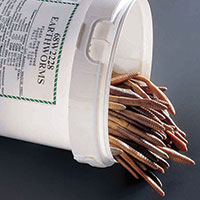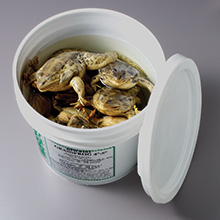Vacuum Packaging
 Most Ward's Science specimens are available in vacuum sealed heavy-duty laminate bags. Vacuum packing ensures little or no mess when opening. The holding solution, Ward’Safe®, a non-toxic, non-formaldehyde holding solution, is retained in the specimen tissue – not in the bag. Vacuum-packaging also guarantees freshness!
Most Ward's Science specimens are available in vacuum sealed heavy-duty laminate bags. Vacuum packing ensures little or no mess when opening. The holding solution, Ward’Safe®, a non-toxic, non-formaldehyde holding solution, is retained in the specimen tissue – not in the bag. Vacuum-packaging also guarantees freshness!
- Minimal fluid in bag
- Easy to dispense to students
- Lower weight, more economical shipping
- Can be used for temporary storage of specimens in use
Pail Packaging
 Select Ward's Science specimens are available in pails. The pail pack stores specimens in Ward’Safe® solution, a non-toxic, non-formaldehyde holding solution. This helps eliminate any worry of dehydrated specimens. Pail packs also provide convenient storage between class times.
Select Ward's Science specimens are available in pails. The pail pack stores specimens in Ward’Safe® solution, a non-toxic, non-formaldehyde holding solution. This helps eliminate any worry of dehydrated specimens. Pail packs also provide convenient storage between class times.
- Best for long-term storage
- Can be tightly re-sealed
- Container can be re-purposed in your lab when empty
Shelf Life
Although the shelf life of the specimen is indefinite, we recommend only purchasing what is needed for one school year to ensure best quality.
Most of our preserved specimens are offered in a variety of colored latex injections, enabling students to easily find and identify features of the circulatory system. All of our injected specimens, with the exception of the shark, abide by the following color guidelines:
Plain Specimen
A plain specimen has no color injections. All specimens are available as plain specimens.
Single Injected Specimen
A single injected specimen has its arterial system (the part of the circulatory system leading away from the heart) injected with red colored latex.
Double Injected Specimen
A double injected specimen has its venous system (the part of the circulatory system that allows blood to return to the heart) injected with blue colored latex in addition to having the arterial system filled with red colored latex.
Triple Injected Specimen
A triple injected specimen, in addition to having the arterial and venous systems colored, has the hepatic portal system (a part of the circulatory system that conveys nutrients absorbed through the small intestines to the liver) filled with yellow latex.
Shark Latex Injections
Single Injected Shark
A single injected shark follows the same prototype as above, with the arterial system injected with red colored latex.
Double Injected Shark
A double injected shark, in addition to having the arterial system filled with red colored latex, has the hepatic portal system injected with yellow colored latex.
Triple Injected Shark
A triple injected shark has red colored latex in the arterial system, yellow colored latex in the hepatic portal system, and blue colored latex in the venous system.
Invertebrate Injections
Color- injected invertebrate generally only have one color for the entire circulatory system. Examples are the single injected crayfish, starfish, and squid. In these specimens the latex color is chosen for its ability to be easily distinguished against the background of the vessels.





 Most Ward's Science specimens are available in vacuum sealed heavy-duty laminate bags. Vacuum packing ensures little or no mess when opening. The holding solution, Ward’Safe®, a non-toxic, non-formaldehyde holding solution, is retained in the specimen tissue – not in the bag. Vacuum-packaging also guarantees freshness!
Most Ward's Science specimens are available in vacuum sealed heavy-duty laminate bags. Vacuum packing ensures little or no mess when opening. The holding solution, Ward’Safe®, a non-toxic, non-formaldehyde holding solution, is retained in the specimen tissue – not in the bag. Vacuum-packaging also guarantees freshness! Select Ward's Science specimens are available in pails. The pail pack stores specimens in Ward’Safe® solution, a non-toxic, non-formaldehyde holding solution. This helps eliminate any worry of dehydrated specimens. Pail packs also provide convenient storage between class times.
Select Ward's Science specimens are available in pails. The pail pack stores specimens in Ward’Safe® solution, a non-toxic, non-formaldehyde holding solution. This helps eliminate any worry of dehydrated specimens. Pail packs also provide convenient storage between class times.
